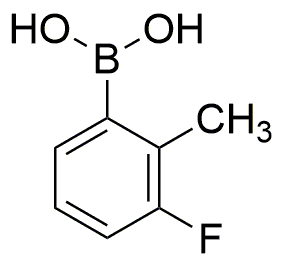3-Fluoro-2-methylphenylboronic acid is widely utilized in research focused on:
- Pharmaceutical Development: This compound is crucial in the synthesis of various pharmaceuticals, particularly in the development of targeted therapies for cancer. Its ability to form stable complexes with biomolecules enhances drug efficacy.
- Organic Synthesis: It serves as a versatile building block in organic chemistry, allowing researchers to create complex molecules through cross-coupling reactions. This is particularly beneficial in the production of fine chemicals and agrochemicals.
- Materials Science: The compound is used in the development of advanced materials, including polymers and nanomaterials, which have applications in electronics and coatings, providing improved durability and performance.
- Bioconjugation: Its boronic acid functionality allows for selective binding to diols, making it useful in bioconjugation techniques for labeling biomolecules, which is essential in diagnostics and therapeutic applications.
- Environmental Chemistry: This compound can be employed in the detection and removal of pollutants, particularly in water treatment processes, due to its reactivity with specific contaminants, thus contributing to environmental sustainability.
General Information
Properties
Safety and Regulations
Applications
3-Fluoro-2-methylphenylboronic acid is widely utilized in research focused on:
- Pharmaceutical Development: This compound is crucial in the synthesis of various pharmaceuticals, particularly in the development of targeted therapies for cancer. Its ability to form stable complexes with biomolecules enhances drug efficacy.
- Organic Synthesis: It serves as a versatile building block in organic chemistry, allowing researchers to create complex molecules through cross-coupling reactions. This is particularly beneficial in the production of fine chemicals and agrochemicals.
- Materials Science: The compound is used in the development of advanced materials, including polymers and nanomaterials, which have applications in electronics and coatings, providing improved durability and performance.
- Bioconjugation: Its boronic acid functionality allows for selective binding to diols, making it useful in bioconjugation techniques for labeling biomolecules, which is essential in diagnostics and therapeutic applications.
- Environmental Chemistry: This compound can be employed in the detection and removal of pollutants, particularly in water treatment processes, due to its reactivity with specific contaminants, thus contributing to environmental sustainability.
Documents
Safety Data Sheets (SDS)
The SDS provides comprehensive safety information on handling, storage, and disposal of the product.
Product Specification (PS)
The PS provides a comprehensive breakdown of the product’s properties, including chemical composition, physical state, purity, and storage requirements. It also details acceptable quality ranges and the product's intended applications.
Certificates of Analysis (COA)
Search for Certificates of Analysis (COA) by entering the products Lot Number. Lot and Batch Numbers can be found on a product’s label following the words ‘Lot’ or ‘Batch’.
*Catalog Number
*Lot Number
Certificates Of Origin (COO)
This COO confirms the country where the product was manufactured, and also details the materials and components used in it and whether it is derived from natural, synthetic, or other specific sources. This certificate may be required for customs, trade, and regulatory compliance.
*Catalog Number
*Lot Number
Safety Data Sheets (SDS)
The SDS provides comprehensive safety information on handling, storage, and disposal of the product.
DownloadProduct Specification (PS)
The PS provides a comprehensive breakdown of the product’s properties, including chemical composition, physical state, purity, and storage requirements. It also details acceptable quality ranges and the product's intended applications.
DownloadCertificates of Analysis (COA)
Search for Certificates of Analysis (COA) by entering the products Lot Number. Lot and Batch Numbers can be found on a product’s label following the words ‘Lot’ or ‘Batch’.
*Catalog Number
*Lot Number
Certificates Of Origin (COO)
This COO confirms the country where the product was manufactured, and also details the materials and components used in it and whether it is derived from natural, synthetic, or other specific sources. This certificate may be required for customs, trade, and regulatory compliance.


